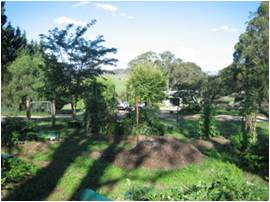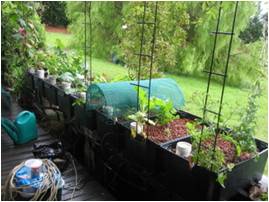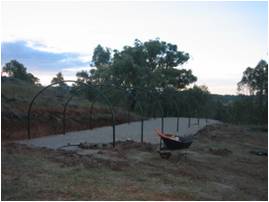Bungonia Creek - Produce
As part of our escape to the country, we were keen to “take control of what you eat”. To that end we are trialling three different methods of local, small scale (ie backyard) food production. These three methods are:-
· A Mandala vegetable garden
· An aquaponics system
· A shadehouse with wicking beds
We are currently growing only enough produce for our own consumption, but once we have a little more experience with the pros and cons of the different techniques we will be selling the surplus at local farmers markets.
Mandala vegetable garden
Our vegetable garden was designed on inspiration from Linda Woodrow via her book “The Permaculture Home Garden”. The term “mandala” comes from a Sanskrit word for circle and the garden is made up of six circular beds around a central circular pond.
The thing that impressed us with the concept of mandala gardens was the way all the elements work together in a synchronicity that makes the whole much greater than the sum of the parts. At the moment we are incorporating companion planting and crop rotation techniques to maximise productivity.

Aquaponics System
Aquaponics is based on productive systems as they are found in nature. Early forms of aquaponics were practiced by the Aztecs who built chinampas over 500 years ago. Nowadays, it can be loosely described as the combination of aquaculture and hydroponics and this is where the name aqua-ponics originates. Aquaponics combines both systems, and in doing so cancels out the negative aspects of each. Instead of adding toxic chemical solutions to grow plants, aquaponics uses highly nutritious fish effluent that contains almost all the required nutrients for optimum growth. Instead of discharging water, aquaponics uses the plants and the media in which they grow to clean and purify the water, after which it is returned to the fish tank. This water can be reused indefinitely and only needs to be replaced when it is lost through transpiration and evaporation. Aquaponics uses only 2% of the amount of water used to grow vegetables in the earth. There are two enthusiastic proponents of aquaponics in Australia:-
Joel Malcolm in Perth with his website Backyard Aquaponics and
Murray Hallam near Brisbane whose website is Practical Aquaponics
Small aquaponics system

Our small aquaponics system, originally set up as a pilot for the larger greenhouse system, comprises 4 grow beds (60 litre recycling tubs) and a 220 litre nutrient supply tank, which can either be stocked with fish, or a natural source of nutrient such as urea, seaweed concentrate, or worm tea. This system would easily fit on a balcony, back deck, or in a suburban backyard, and can provide a continuous supply of herbs and fresh vegetables all year round. It has provided us with the experience and knowledge to build the larger aquaponics system.
Greenhouse aquaponics system

The greenhouse aquaponics system has now been “in production” since 2011. It comprises:-
· a 2500 litre fish tank containing approximately 50 silver perch
· 4 grow beds filled with 20mm river stones (capacity of 2000 litres)
· a 6m x 0.8m x 0.4m sump (capacity of ~2000 litres) with 8 floating raft sections each containing 12 holes.
Water is continuously pumped from the sump to the fish tank where it creates a swirling motion that simulates a slow moving stream. Water then overflows from the fish tank into the grow beds where it “floods and drains” back into the sump via syphons.
So far we have grown a range of vegetables in the grow beds including beetroot, tomatoes, broccoli, red cabbage, perpetual spinach, mizuna, roquette, tatsoi, asian vitamin greens and herbs including basil and parsley. We have used the floating rafts mostly for lettuce to date, but will start to experiment with other vegetables as the rafts are capable of producing 24 lettuces each week!!
From observation, it would appear that plants grown in the greenhouse aquaponics system grow at twice the rate of those planted outside in the soil. This is not surprising as they have continuous access to water and nutrients, and an environment sheltered from the extremes of wind and weather.
Shadehouse with wicking beds
During our first summer on the property we struggled to grow vegetables because of the extreme hot weather and the drying winds. We would plant healthy seedlings and they would have withered and died in 24 hours. We did overcome this with shadecloth tunnels but we decided to build a shadehouse. In looking for shadehouses we can across someone who had combined his shade house with wicking beds and had documented his journey in a website (unfortuneately his website is no longer available)
Our shadehouse was completed in 2012 but with the hot summers it has been used as a sanctuary for many of the plants that were getting overheated in the green house and even outside! Wicking bed are currently on hold until we can clear more space in the shade house.
